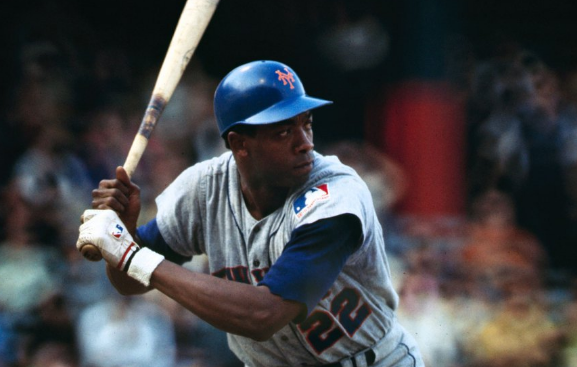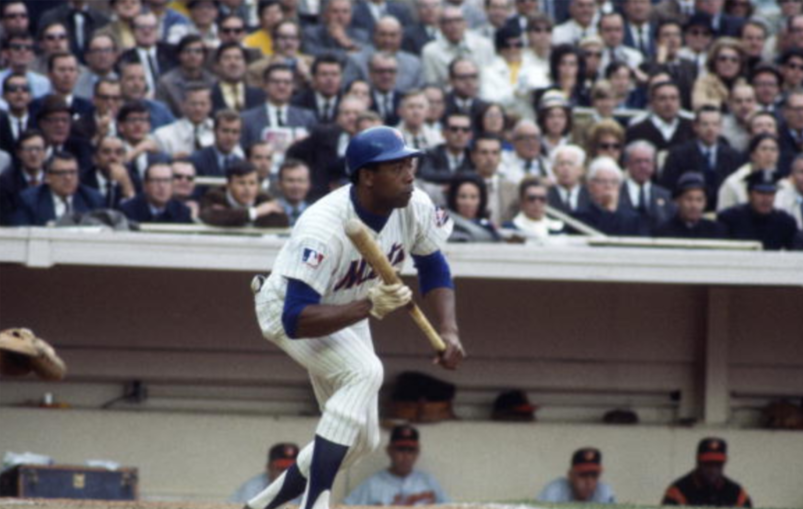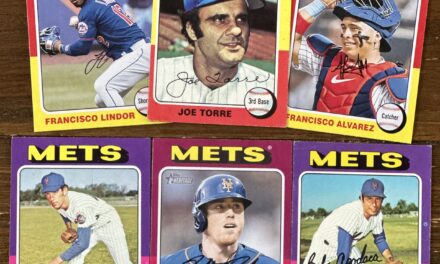
He was with his new team for hardly a month before he made his presence felt and it wasn’t with his bat or his glove. Donn Clendenon, the free swinging, free-talking, outspoken new first baseman for the New York Mets was in the field for New York on July 9, 1969. Tom Seaver was on the mound and the opponent was the Chicago Cubs whom the Mets trailed by 4.5 games.
In perhaps the greatest game ever pitched by a Met, Seaver retired the first 24 Cubs that faced him and headed to the ninth with a perfect game intact. In the ninth, Tom Terrific retired Randy Hundley on a bunt and then faced back-up outfielder Jimmy Qualls. Very little was known of Qualls as he was seldom used by Chicago, yet he hit a clean single to break up the perfect game and no-hitter.
Noticing a slump in his pitcher’s shoulders after the hit, Clendenon walked to the mound and told Seaver, “All right, Tom,” he said, “you (messed) up”.
Seaver, with a serious on-field manner hardened in the Marines, took such a challenge seriously: ” I (messed) up?” he responded.
“Yeah, Tom,” finished Clendenon. “You pitched a great game and I’m proud of you. We still have to finish the inning though, so don’t let down now.” Seaver didn’t let down, retiring the final two Cubs without incident to preserve a Mets win. He walked off the field to a standing ovation. The Mets crept closer to a dispirited Cubs team whose NL East lead continued to shrink.
Such was the manner of Donn Clendenon, a man never afraid to take a strike or take a jab at an opposing player or even a teammate.
Clendenon grew up in a home where academia was preached. He finished second in his high school class, and lettered in 9 sports. His stepfather urged him to play baseball at an early age and as Clendenon matured, he seemed to gravitate toward baseball even though he had scholarships galore for several sports. He was even offered an opportunity to play basketball with the Harlem Globetrotters.
In 1957, after a short career in teaching, Clendenon went to a try-out camp run by the Pittsburgh Pirates. He was signed shortly thereafter as an amateur free-agent. After five years in the minors, Clendenon made his Major League debut in September, 1961. In his first full year, in ’62, he batted .302 with seven home runs and 28 RBIs in 80 games. He finished second in Rookie of the Year balloting to Ken Hubbs.
Over the next several years, Clendenon developed into proficient hitter, with a 98 RBI season in 1966 as his apex, in a line-up that included Willie Stargell and Roberto Clemente. He also developed a reputation as a ‘free swinger’ as he led the league in strikeouts in 1963 and 1968, and finished second in 1966 and third in 1965.
After the ’68 season, the Pirates left Clendenon unprotected for the 1968 MLB expansion draft as they were grooming Al Oliver for the first base job. The Montreal Expos drafted him and after a failed attempt to trade him to Houston which involved legal maneuvering and the intervention of commissioner Bowie Kuhn, Clendenon finally reported back to the Expos on April 19, 1969. Scarcely two months later, on June 15, 51 years ago today, Montreal sent him to the Mets in a trade for Steve Renko, Kevin Collins and two minor leaguers.
Mets historians and fans alike feel Clendenon was the missing piece of the mosaic that turned the 1969 Mets from a good team to a championship caliber team. Many of his teammates agreed.

Sports Illustrated
“He [Clendenon] was the catalyst on the team,” outfielder Art Shamsky recalled to Stanley Cohen, author of A Magic Summer. “You can talk about our pitching, which was great, and whatever else, but until June we were just a potentially good team. When Clendenon joined us, he gave us the right-handed power we needed, some more experience, and we became a really good team from that point on.” Third baseman Wayne Garrett agreed, telling Cohen, “Clendenon was probably the key to our whole season, because when he came over we really came alive.”
Alive indeed. When Clendenon joined the Mets, they were 11.5 games behind the Cubs. By the All-Star break, they were just 4.5 games back. Manager Gil Hodges, a devotee of platooning even star players at times, did the same with Clendenon as his newly acquired first baseman split time with Ed Kranepool. Playing part-time, Clendenon, in a pitcher’s league, playing in a pitcher’s park, batted .252 and slugged .455 for the Mets, with 12 homers and 37 RBIs in just 202 at-bats.
He started slowly for New York after the trade, but gained momentum as the season wore on. And his tenacity and outspoken nature were apparent from day one. When the Cubs came to Shea Stadium in early September still leading the Mets by 2.5 games, it was Clendenon who helped the Mets sweep the short series with a home run in game two. Clendenon also hit two home runs against the St. Louis Cardinals in the game that clinched the NL East title on September 24.
Clendenon did not make an appearance in the National League Championship Series against the Atlanta Braves. Atlanta rolled out three right-handed starters in the eventual three-game sweep by the Mets, and Hodges, true to his platooning style, opted for Kranepool. The World Series was a different story.
What is sometimes lost in the euphoria of the unexpected victory by the Mets against the Baltimore Orioles, is the amount of chatter surrounding the series. The jawing was partly between the two squads and in part in the clubhouse after a game, especially after the game one loss by the Mets. Before the Series even saw its first pitch, Frank Robinson said on the field , “No hard feelings, but you guys can’t beat us,” Clendenon replied that the Mets would “kick your ass, maybe in four straight games!” Clendenon’s confidence was boosted by the fact that Baltimore had two left-handers in their powerful four-man rotation, and were in fact cutting to a three-man rotation for the Series with southpaws scheduled to throw four of the first five games.
After the Mets lost game 1, Clendenon noticed the Mets clubhouse was sullen and he asked Hodges if he could address the team. Hodges agreed and what followed was pure Clendenon:
Donn started by letting Seaver off the hook. They had chased the team’s (and league’s) best pitcher, but the Orioles still didn’t dominate the game. “Gentlemen, trust me!” he shouted. “We have much better pitching than they do. Our pitchers are better and they throw a hell of a lot harder than (Baltimore’s) pitchers. Let’s not get down, and let’s look at what we can do if we just play our game.” He even told reporters after his chat unequivocally, “Trust me fellows! We will win!”
Now this boast did not get the press a la Joe Namath’s or Mark Messier’s guarantees did, but it was still gutsy coming from a player whose team was already down a game to a heavily favored opponent.
Undaunted from the loss in game one, Clendenon, outspoken as always, continued his verbal sparring before game 2. During batting practice, he got into a spat with Paul Blair and it ended with Clendenon shouting, “We are going to send you home with your (freaking) head between your legs.”
A man of his word, Clendenon broke a scoreless tie with fourth inning home run off of Dave McNally. Also, he played excellent defense at first, scooping out a number of throws from his infielders including one from Ed Charles to record the final out.
In game 4, Clendenon once again opened the scoring in the second with a homer of Mike Cuellar. The score stayed 1-0 until the ninth when the Orioles put runners on first and third with one out against Seaver. Brooks Robinson then lined a fly ball to right center that was caught by Ron Swoboda after a full-extension dive, truly one of the finest catches ever in a World Series game.

Clendenon always maintained that Swoboda should have played the ball on a hop, that it was the go-ahead runner on first (who may have come around to score had the ball gotten by Swoboda). He made a point of spelling out his thinking to Swoboda when they got to the dugout.
With the Mets up three games to one, the Orioles struck quickly in game 5 taking a 3-0 lead. In the bottom of the sixth, fate may have stepped in to seal the championship. Cleon Jones was awarded first base on what would later be known forever as the Shoe Polish Incident. What is sometimes overlooked is that the next batter, Donn Clendenon, smacked a two-run home run to cut the Orioles’ lead. Al Weis homered later to the tie the game, and the Mets rallied for two in the eighth to give them their first lead. That lead held-up and the Mets had their unlikely, but wondrous championship.
As pandemonium broke out on the Shea infield, Clendenon made his way to the clubhouse to be told he had been named the Most Valuable Player of the World Series—despite strong cases for Tommie Agee, Jerry Koosman, and Al Weis. Clendenon’s three homers tipped the scale in his favor for the prestigious MVP award. The last man to join the 1969 Mets stood the tallest at their hour of victory.
For the series, Clendenon batted .357 (5 for 14) with three home runs and four RBI. His three home runs remain tied for most home runs in a five-game Series with the Phillies’ Ryan Howard, who equaled it in the 2008 World Series.
In 1970, eyebrows were raised when Ed Kranepool, the last player from the Mets inaugural 1962 season, was sent to Tidewater, leaving first base the exclusive province of Clendenon. He responded with his best full season since 1966, one of his best ever, in fact, as he batted .288, slugged .515, clubbed 22 homers, and drove in 97 runs—a Mets record for RBIs at the time. He even had a 7-RBI game on July 28. Interestingly, Clendenon was overlooked for an All-Star birth even though his manager filled in the roster with extras. Clendenon never made an All-Star appearance in his 12-year career.

There was no Mets Magic in 1970 though as they finished in third place, six games behind the Pirates.
In 1971, Kranepool returned from the minors with a vengeance and had a career year, greatly reducing Clendenon’s playing time. With John Milner and Mike Jorgensen waiting in the wings, Donn Clendenon became the odd man out and was released from the Mets at the end of the 1971 season. After a short stint with the Cardinals, Clendenon retired from baseball.
Clendenon pursued a law degree at Duquesne University. He graduated with a Juris Doctor in 1978 and practiced law in Dayton, Ohio. He also had a bout with drug addiction, all of which is recounted in his book, Miracle In New York, in which he wrote about growing up in Atlanta, the magic of the ’69 Mets, earning his law degree and battling drug addiction as he neared his 50th birthday.
As part of his rehabilitation, Clendenon had frequent medical check-ups and during one, was found to have leukemia. As was his ilk, he did not stay home and wait for the inevitable, rather, he worked for many years as a chemical dependency counselor and was devoted to helping others in their recoveries. Clendenon died from leukemia on September 17, 2005. He is survived by his wife, Anne; his sons, Donn, Jr. and Val, his daughter, Donna Clendenon, and six grandsons. Shortly before his death, he was inducted into the Georgia Sports Hall of Fame.
Donn Clendenon was an integral part of the Mets 1969 miracle run. As stated, his presence solidified a good team and made them a great team. He was, at times, a clubhouse leader and at other times, an irritant to his opponents. His articulate, outspoken manner is a part of the lore of the unforgettable story of the ’69 Mets and his contributions will not be forgotten.















